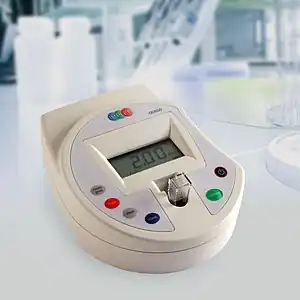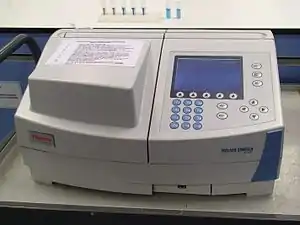OD600
OD600 (Also written as O.D. 600, D600, o.d. 600, OD600) is an abbreviation indicating the optical density of a sample measured at a wavelength of 600 nm. It is a commonly used in Spectrophotometry for estimating the concentration of bacteria or other cells in a liquid as the 600nm wavelength does little to damage or hinder their growth. Since optical density in case of OD600 measurements results from light scattering rather than absorption, size and shape as well as dead cells and debris of a cell may add to light dissipating. Distinctive cell types that are at densities of the same level (eg. cell/mL), may, there fore, show varying values OD600, when estimated on a similar instrument.


Measuring the concentration can indicate the growth stage of cultured cell population, i.e. whether it is in the lag phase, log phase, or stationary phase.[1] This is done by measuring the absorbance of the OD600 light with the use of a Spectrophotometer. A growth curve can then be constructed by taking absorbance measurements as a function of time. As a general rule, cells should be harvested towards the end of the log phase, using the optical density of the samples to determine when this point has been reached. Cells are routinely grown until the absorbance at 600 nm (known as OD600) reaches approximately 0.4 prior to induction or harvesting.
OD600 is preferable to UV spectroscopy when measuring the growth over time of a cell population because at this wavelength, the cells will not be killed as they would under too much UV radiation. UV radiation has also been shown to cause small to medium-sized mutations in bacteria, potentially altering or destroying genes of interest.[2]
OD600 is a type of turbidity measurement.
References
- Mandelstam J, McQuillen K, Dawes I (eds): Biochemistry of Bacterial Growth. 3rd Ed. Blackwell, Oxford, 1982 .
- Sutton, Scott. "Measurement of Cell Concentration in Suspension by Optical Density". microbiologynetwork.com. The Microbiology Network. Retrieved 26 September 2019.